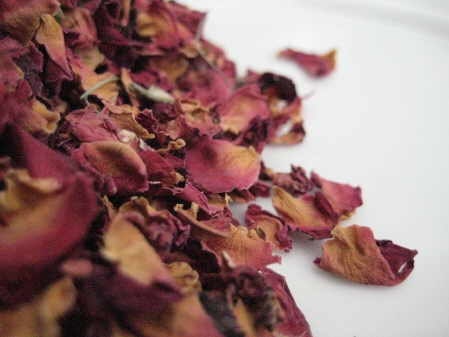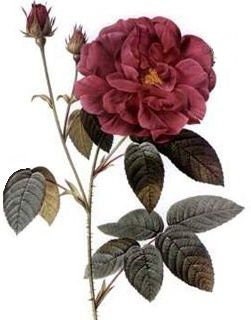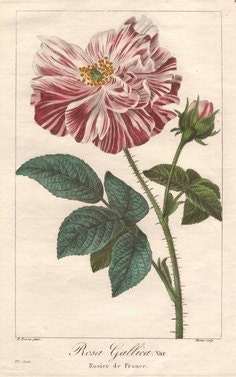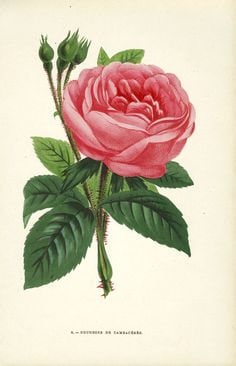



Red Rose Petals – Rosa Gallica Officinalis- The Apothecary's Rose -Herbal Tea - 50, 100 or 500 grams
$11.53
Red Rose Petals (Dried) from the Apothecary’s Rose (Rosa gallica officinalis) have long been prized not only for their delicious aroma but for its untold beauty as well. Women have been compared to roses, and women have highly prized them. Cleopatra had her living quarters filled with the petals of roses so that when Marc Antony met her, he would long remember her for such opulence and be reminded of her every time he smelt a rose thereafter. Her scheme worked for Marc Antony fell madly in love with her. Such is the power of the rose.
Recipe for Red Rose Petals Ice Cream
This is an unusual recipe and is Edwardian in origin. Make sure if you are not using red rose petals purchased from an organisation like us that the roses you use are not sprayed with pesticides in any way. Florist obtained roses are completely unsuitable for eating because of the various processes used to grow them, force them and make sure they have a shelf life.
600ml full fat milk
yolks of 6 free range eggs
200 grams caster or even icing sugar
600ml double cream
250 grams red rose petals
60ml of good rosé wine – don’t use one that you haven’t enjoyed drinking.
Method
Infuse the rose petals with the rosé wine and leave for at least 24 hours in a sealed container agitating occasionally.
Beat the egg yolks with the sugar, the mixture will take on a pale yellow colouring as a result rather than the vivid yellow of the egg yolks. Add the milk and mix thoroughly and then stir over a low heat in a bain marie (basin standing in a saucepan of hot water but do not let the base of the basin touch the hot water).
Stir constantly and the mixture will thicken turning into a custard. Remove from heat and leave until cold.
Whip the double cream until it thickens and leaves loose collapsible peaks when you remove the whisk. Fold the cream into the cold custard. Strain the rose petals from your infused mix and fold the rose infused wine into the custard and cream you have previously prepared.
Freeze in an ice cream churn until thickened and frozen. If you don’t have an ice cream churn you can make this in a freezer but you MUST remove the mix from the freezer every hour or so and mix again thoroughly to stop the formation of ice crystals, If you don’t the resultant ice cream will have a granular texture and be unpleasant.
General and Historical Uses of Red Rose Petals
In ancient mythology, rose water was used in gourmet dishes and in love potions. Petals were used in healing incense and sachets, and burned to provide a restful night’s sleep. The essential oil was used in ritual baths to provide peace, love, and harmony within the self. The hips were strung like beads and worn to attract love. Rose petals sprinkled around the home calmed personal stress and upheavals in the home.
Ancient literature abounds with references to roses used for medicinal, botanical and cosmetic purposes and speaks of their use for feeding the body, the soul and the spirit. Medical texts written on stone tablet mention possibly a wild rambling rose, referred to as arnurdinnu, for medical purposes.
In Persia the much sought after rose oil and oil of attar was made from the heavenly scented damask roses and traded all around the world. The Greeks used rose-scented olive oils for perfume, to keep illness at bay and to anoint their dead. But the Romans outdid the Greeks when Nero, the hedonistic emperor, 1st century AD, dumped tons of rose petals on his dinner guests, nearly suffocating some.
The apothecary rose, R. Gallica Officinalis, first recorded in the 13th century, was the foundation of a large industry near the city of Provins, France. Turned into jellies, powders and oils, this rose was believed to cure a multitude of illnesses.
In England, the rose became truly “royal” during the 15th century War of the Roses: The House of York adopted a white rose (R. alba?), the House of Lancaster decided to take a red rose (R. Gallica?). The winner of this war, Tudor Henry VII, merged his red Lancastrian rose with the white rose of his York bride and thus created the Tudor Rose, the Rose of England.
American Indians were well aware of the uses and beauty of the rose. They too adorned their brides with roses. Some of their native medicines called for roses as well. They combined the petals of wild roses and the fat of bears and used this mixture to cure mouth sores. A powder was made from rose petals and this was used on any type of blister or fevered sores. They used rainwater that had been infused with roses to bathe sore eyes and the stringing pulp of the rose stem was mashed and applied to boils.
Honey of Roses, also official in the United States Pharmacopoeia, is prepared from clarified honey and fluid extract of roses. It is considered more agreeable than ordinary honey and somewhat astringent. In olden days, Honey of Roses was popular for sore throats and ulcerated mouth and was made by pounding fresh petals in a small quantity of boiling water, filtering the mass and boiling the liquid with honey. Honey of roses is used in gargles and lotions to wash sores, either in the mouth, throat or other parts, both to cleanse and heal them.
Red rose-water is well known, it is cooling, cordial, refreshing, quickening the weak and faint spirits, used either in meats or broths to smell at the nose, or to smell the sweet vapours out of a perfume pot, or cast into a hot fire-shovel. It is of much use against the redness and inflammation of the eyes to bathe therewith and the temples of the head. The ointment of roses is much used against heat and inflammation of the head, to anoint the forehead and temples and to cool and heal red pimples.
Rose Vinegar, a specific on the Continent for headache caused by hot sun, is prepared by steeping dried rose petals in best distilled vinegar, which should not be boiled. Cloths or linen rags are soaked in the liquid and are then applied to the head.
Throughout the history of civilization, people from around the world have held the rose close to their hearts. We know now that roses have existed much longer than any of us imagined. Even before human time roses flourished: 35 million-year-old fossilized rose flowers and hips have been found in Europe and petrified rose wreaths have been unearthed from ancient Egyptian tombs.
We find the beginning of the roses’ history in legend. The Garden of Eden was full of thornless roses. When Eve fell from grace, it is said that from then on the rose grew thorns on its stems. For over 3,000 years the rose has been called the queen of flowers.
In Greek mythology, Aphrodite, Goddess of Love, is said to have created the rose which arose from her tears and the blood of her lover Adonis. The Romans, turning Aphrodite into their goddess Venus, also adopted the rose: it became the symbol of love and beauty. Cupid, offering a rose when trying to bribe the God of Silence to hush Venus’s amorous escapades, made the flower into a symbol for secrecy: Roman dining room ceilings were decorated with roses, reminding guests to keep secret what had been said during dinner. Sub Rosa, under the rose, up to this day means “confidentially.”
The early Christians saw the five wounds of Christ in the five petals of the Rosa sancta. However, in view of the decadence connected with the Roman rose, the official Christian Church was reluctant to consider the rose a religious symbol. Only after much hesitation was the red rose declared a symbol of the blood of the martyrs. But not only in Christian literature, also in ancient Confucian and Buddhist religious documents we find references to the rose.
The first known paintings of a rose are actually frescoes. The earliest example was discovered in Crete around 1600 B.C. Scientist believe it was Greek colonist who brought the first rose to Italy. The Romans cultivated this great beauty and named it Rosa Gallica. Newly married couples were often crowned with roses. Roman high society women used petals much like currency believing that they could banish wrinkles if used in poultices. Rose petals were often dropped in wine because it was thought that the essence of rose would stave off drunkenness and victorious armies would return to be showered with rose petals from the civilians that crowded the balconies above the streets.
The oldest garden rose is the Rosa Gallica Officinalis, the apothecary rose. Old garden rose classes include the Albas, Centifolias and Damasks with their heady old rose fragrance. These have long been grown for their beauty and ability to grow in a most carefree manner. That they bloom only in mid-summer, as do their wild relatives, predating the later repeat flowering roses, is of little consequence in comparison with their easy care beauty and fragrance. Already in 35 AD the Roman writer Virgil wrote about the cultivation of roses and he extolled the virtues of “twice -bearing” roses, probably referring to the Autumn Damasks. But it would still be many centuries before the arrival in the West of the first true repeat-flowering roses form China from which the modern hybrid tea roses would be developed! During the Middle Ages the returning Crusaders brought with them roses from the Middle East.
During these so-called Dark Ages ornamental gardening was not a priority with ordinary people: the newly imported roses were kept alive in monastery gardens. The renewed interest in the garden rose came with 19th century Empress Josephine, wife of Napoleon Bonaparte. This ambitious woman’s dream was to establish a rose garden in Malmaison containing a collection of all the roses of the world. Although France was at war with every country in Europe and isolated by blockades, arrangements were made by England and France to bring to Josephine’s garden newly discovered roses from China.
Under the terms of Etsy's Medical Drug Claims policy, sellers on Etsy are forbidden to share knowledge of the traditional or medicinal uses of their products. It would be beneficial for you to research a product we feature prior to placing any order. Message us via ‘Etsy Conversations and we will try to assist with any information we can
This information and the products themselves have not been evaluated by the FDA. They are not intended to diagnose, treat, cure, or prevent any disease or condition. If you have a health concern or condition you would be wise to consult your doctor or a qualified practitioner
Payments
We accept direct payments through Etsy by credit/debit card or Paypal transfers to make it as easy as possible for you.
You have the right to cancel an order within 24 hours of placing the order or by request at any time prior to despatch.
Shipping from United Kingdom
We aim to despatch within 2 working days of receipt of order but will inform you if this differs for some reason for any product you may have ordered. We use a tracking service which requires your parcel to be signed for and you will be able, in many instances, to track the progress of your package from door to door.
Orders to destinations outside the EU will have a customs and excise declaration - customers from outside the UK should make themselves aware of any local restriction on imported plant material and the Natural Herbalist can accept no liability for custom and excise intervention in your order at transit or delivery stage.
PLEASE READ – IMPORTANT
ALL ORDER WILL ONLY BE DESPATCHED USING TRACKED AND SIGNED FOR DELIVERY WHERE APPROPRIATE (some countries provide tracked OR signed for only rather than both)
WE GO TO GREAT LENGTHS TO PROVIDE TRACKING ON YOUR PURCHASE SIMPLY SO THAT YOU CAN, AT ANY POINT ON YOUR PARCEL’S JOURNEY, AND WHERE APPROPRIATE AND APPLICABLE, CHECK ON YOUR PARCEL’S PROGRESS.
TRACKING NOT ONLY INFORMS YOU OF WHERE YOUR PARCEL IS BUT ALSO IF THERE ARE ANY PROBLEMS WITH DELIVERY THAT ONLY YOU CAN CORRECT SUCH AS MISADDRESSED PARCELS, NOT BEING IN WHEN YOU HAVE TO SIGN FOR THE PARCEL OR RE-ARRANGING A DELIVERY TO SUIT YOUR SCHEDULE.
AVOIDING USE OF TRACKING WILL ONLY LEAD IN SOME CIRCUMSTANCES TO YOU LOSING YOUR ORDER WHERE YOUR ASSISTANCE IS REQUIRED BY THE CARRIER TO COMPLETE DELIVERY.
PLEASE USE THE TRACKING SERVICE – IT IS SIMPLE AND EASY TO USE AND WILL HELP YOU AVOID DISAPPOINTMENT
We hope you enjoy your purchase
YOU WILL BE REQUIRED BY YOUR DOMESTIC POSTAL SERVICE TO SIGN FOR YOUR PARCEL UPON ITS DELIVERY – IF YOU ARE NOT AVAILABLE TO SIGN FOR YOUR PARCEL YOUR DOMESTIC CARRIER WILL LEAVE A NOTICE FOR YOU TO CONTACT THEM REGARDING YOUR ARRANGEMENT FOR A MORE SUITABLE TIME FOR DELIVERY OR YOUR COLLECTION OF THE ITEM FROM THE SORTING OFFICE – THEY WILL NORMALLY ALLOW UP TO THREE WEEKS FOR YOU TO ACCOMPLISH THIS.
IF, FOR SOME REASON, YOU DO NOT RE-SCHEDULE A SUITABLE TIME FOR YOUR LOCAL CARRIER TO RE-DELIVER YOUR PARCEL, IT MAY BE RETURNED ULTIMATELY TO US. THIS IS BY NO MEANS CERTAIN AND ALWAYS TAKES LONGER THAN THE OUTWARD JOURNEY BUT ONLY UPON RECEIPT OF THE RETURNED PARCEL WILL A REFUND ON THE PURCHASE PRICE BE MADE. WE WILL NOT SEND THE ITEMS AGAIN NOR REFUND THE ORIGINAL CARRIAGE CHARGE.
Our Shipping Terms and Conditions are shown in detail here...
http://www.luminescents.net/information/shipping/
Our General Terms and Conditions are shown in detail here...
http://www.luminescents.net/information/terms-conditions/
No MSDS or COA certification is provided with your order as per our terms and conditions.
Returns & Exchanges
I gladly accept cancellations
Reviews (6)
Average:
Feb 7, 2024
Great quality and very quick delivery
Jul 26, 2021
good quality product. I would definitely purchase again!
Jul 10, 2020
Feb 26, 2020
Bought lots of herbs and flowers. Great quality, arrived quickly. Wonderful for tea making.
Apr 27, 2019
Thank the you. Wonderful product
